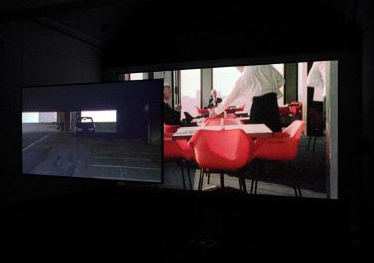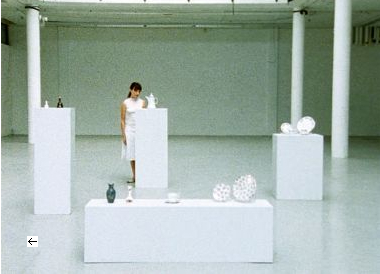Who: Runa Islam
Where: Museum of Contemporary Art, 140 George Street, The Rocks, Sydney
When: Until 21 November, 2010
Although I was in Sydney for a conference on Renewable Energy, I made sure to fit in a visit to MCA while I was there. There was SO much to see that I’m going to bring it to you in three posts. This is number one.
The first exhibition I saw was from Bangladeshi experimental video artist Runa Islam, who grew up in London where she lives and works today. Islam was nominated for a Turner Prize in 2008 and makes some seriously cool video installations that blur the lines between cinema and art, video and sculpture. Inspired by French new wave cinema, she works with 16 and 35mm film where the sound of the film spinning on the reel, combine with a minimalist soundtrack, to become part of the art itself.
The first work I saw was actually one of my favourites. It was a video installation from 2003, titled Scale 1/16 = 1 Foot. It featured two screens: one large projection on the back wall and one smaller screen hanging in front in the centre of the dark room.
The narrative told a story of the Trinity Square multi-storey car park in the provincial town of Gateshead in England, and contrasted it with the architects maquette and vision for the space, as well as images of what it was meant to become: a beautiful modernist-style fine dining restaurant.
The bright orange of the chairs in the restaurant stood out amongst the stark background. Different perspectives were layered on top of one another giving it immense depth. An over the shoulder shot, a long shot, a close up; there was no single point of view.
Be The First To see What You see As You see It was also pretty incredible. It was centered around a girl fascinated with the lid on a china tea-pot; inspecting it first and pushing it a little so it lifts up then falls back in place. I was intrigued, watching her. What was this about?
Then, to my surprise, she purposefully pushed the same lid she was so enamoured with, and let it fall to the ground, smashing into a number of pieces. The footage was slightly slowed, which gave the act incredible beauty and make the fall appear extremely delicate. The exact same thing happened over again with a number of teacups sitting on a white table. Multiple shots captured the teacups falling from different angles. Shards of porcelain lie on the ground in very sharp focus.
This was not to been seen as an aggressive or destructive act. As Islam herself states on a video interview by the Tate Britain, “there is a limit to the table, and as you reach that limit, the object itself continues”. We get the idea that perhaps the china is being freed from the confines of its museum type display.
A film completely without narrative, titled Magical Consciousness, looked more like an abstract painting, vertical panels and lines in black and white intermittently change, the only sound coming from the 16mm film spinning on its reel.
The exhibition made me think about the possibilities of film to open our minds to new perspectives. The way she uses multiple overlapping screens, slows footage, and shows events from different angles, all force the audience to examine these simple everyday images and minute moments in greater detail than we have an opportunity to in real life. It is also clearly an experiment in the use of colour, abstraction, light and sound.
The exhibition runs until 21 November so you have plenty of time to get up to Sydney to check it out. I would highly recommend it.
All photos are by Gerry Johansson, courtesy of White Cube, London.



